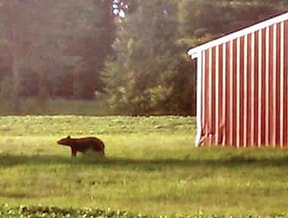
Editor’s Note: This is the first of a three-part series from Highland County Division of Wildlife Officer Jim Karnes about a bear that traveled through Highland County this summer.
The essence of fall creeps closer and closer. The milder temperatures with the shortening of days all signal to start the colorful changes of autumn. Hillsides and valleys once adorned in a canopy of green are now progressing into yellows, reds and gold. The smells of this time of year work together, bringing back memories of last year’s hunts and the dreams for tomorrow’s hunts. It’s a final act in a season of time we call 2015 right before the November winds blow, ushering in the presence of old man winter for creation’s sleep.
Like others, my own anticipations are developing for the opportunities of fall, but I find myself still blanketed somewhat by unanswered questions from this past summer, back to a day this past June.
One by one I continued to check off my to-do list from the Post-it notes. Emails returned, phone calls returned, daily log updates, and statement of facts. Sitting at the district office desk nestled into the mode of catch-up, I was preoccupied.
“Hey Jim, You got a minute?” Bruce Terrill, assistant wildlife management officer asked.
“Sure what’s up,” I responded?
“I hate to bother you, but did you get the voicemail I sent about the bear sighting”? Terrill asked. “I think it might be pretty reputable.”
“Really. That’s exciting. I’ll look into it just as soon as I can,” I said.
With that, both of us were drawn back into the realities of the day’s to-do lists. Little did I know at the time how the days of tomorrow would add up.
“There’s a bear in the parking lot in Marshal.” “That bear’s been seen down at the dog pound.” “He’s just crossed over New Market Road at the cemetery.” One by one those kind of reports started coming in. And many witnesses got cell phone pictures of the year and a half old cub that had been pushed out from his mother.
The sightings continued as the bear’s movement headed southwest into eastern Brown County. With every sighting I had more questions about this particular bear, and bears themselves as time went on. “Where did he come from?” “Where is his mother?” “Could he have been raised in the preserve area.” “Did anyone from over the county line see him?” people asked.
It seemed like with every new sighting, my thirst for answers grew.
Stepping back from the current situation, I started making phone calls with people in our division that have a lot more knowledge and expertise in dealing with the bears in Ohio. My first contact was to a fellow officer in northeastern Ohio, where the majority of bears and sightings in the state come from.
Scott Denamen is assigned in Geauga County, just east of Cleveland and north of Youngstown. He has been the state wildlife officer there for approximately 12 years and currently serves on the division’s training team.
“At one time, I was dealing with what we felt were five different bears coming into the district through Geauga, Ashtabula and Trumbull counties from the Pennsylvania line,” Denamen noted.
At the time of my conversation with him in June he said that, “Within the last week there have been three different ones transitioning through the river and watershed corridors of the county. Every year it seems as though they move through those natural waterways until they turn and start heading back to Pennsylvania.
“Most of the movements have been from juvenile cub bears, who weigh anywhere from 80-125 pounds, but I have had adult males come though as well. The main thing the public should be aware of is not to panic when they see the bear wherever that may be. Enjoy the moment and give the bear its due respect.”
The Ohio/Pennsylvania border is like a continuous land bridge with nothing separating the two states except for a minor creek or hillside. With an estimated population of more than 15,000 black bears in the keystone state, it’s no wonder that Northeastern Ohio has this much bear movement activity.
“Bears are definitely heading west,” said Roger Coup, the district wildlife management supervisor for the northwestern management unit with Pennsylvania Game Commission. “With an approximate population somewhere between 15,000 and 20,000 bears, we continue to have expanding bear populations moving into the northwest region along the Ohio border.”
In the 2014 Fall Bear Hunting season, Pennsylvania hunters harvested 25 black bears, including 13 males and 12 females in Erie, Crawford and Mercer counties. In 2013, a total of 47 bears were taken in those Pennsylvania counties.
Those three counties border the Ohio counties of Ashtabula, Trumbull and Mahoning. There are other Pennsylvania counties that border Ohio. While they had no harvests they are still considered bear management areas.
After my discussions with Denamen and Coup, it seemed that more news on Ohio’s bears was making headlines when a passerby in Fairfield County, outside of Lancaster, found a 168-pound road killed bear on the U.S. Route 33. There had been sightings in this location for several months before.
Since more sightings locally were being reported while the bear that moved through Highland and Brown counties was by then moving into northwestern Adams County, it only added more fuel to my curiosity.
“With all the bears moving through the state, could there be a resident breeding population in Ohio somewhere? If so, where are they located, and how many could there be?”
Find those answers in part two of this series.


